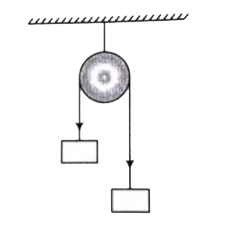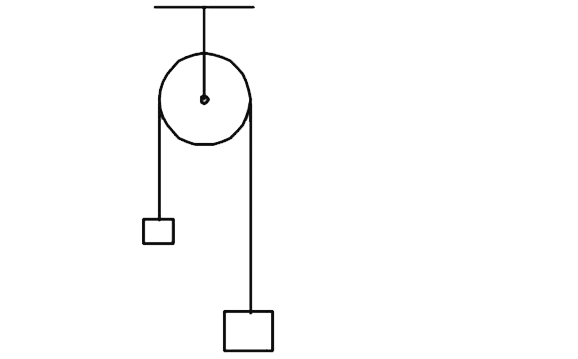The heavier bock in an atwood machine has a mass twice that of the lighter one. The tension in the stirng is 16.0 N when the sytem is set into motion. Find the decrease in the gravitational potential energy during the first second after the system is releaed from rest.
The correct Answer is:A
To solve the problem step-by-step, we will analyze the Atwood machine and calculate the decrease in gravitational potential energy during the first second after the system is released from rest.
Step 1: Understanding the System
In an Atwood machine, we have two blocks connected by a string over a pulley. Let the mass of the lighter block be m and the mass of the heavier block be 2m. The tension in the string is given as T=16N.
Step 2: Determine the Acceleration
Using Newton's second law, we can analyze the forces acting on each block.
For the heavier block (mass 2m):
Fnet=2mg−T=2ma
For the lighter block (mass m):
Fnet=T−mg=ma
From the first equation:
2mg−T=2ma(1)
From the second equation:
T−mg=ma(2)
Step 3: Solve for Acceleration
Adding equations (1) and (2):
2mg−T+T−mg=2ma+ma
This simplifies to:
mg=3ma
Thus, we can solve for acceleration a:
a=g3
Step 4: Calculate the Distance Fallen in One Second
The distance fallen by the heavier block in the first second can be calculated using the equation of motion:
s=ut+12at2
Since the initial velocity u=0 and t=1s:
s=0+12(g3)(12)=g6
Step 5: Calculate the Change in Gravitational Potential Energy
The change in gravitational potential energy (ΔU) is given by:
ΔU=Uinitial−Ufinal
For the heavier block (mass 2m):
ΔUheavy=−2mg⋅g6=−2mg26=−mg23
For the lighter block (mass m):
ΔUlight=mg⋅g6=mg26
Step 6: Total Change in Gravitational Potential Energy
Now we can find the total change in gravitational potential energy:
ΔUtotal=ΔUheavy+ΔUlight
Substituting the values:
ΔUtotal=−mg23+mg26
Finding a common denominator (6):
ΔUtotal=−2mg26+mg26=−mg26
Step 7: Substitute for mg
We know from the tension that:
T=mg+2mg−T⟹3mg=T⟹mg=T3=163N
Step 8: Calculate the Decrease in Potential Energy
Now substituting mg into the potential energy change:
ΔUtotal=−16⋅163⋅g
Using g=10m/s2:
ΔUtotal=−16⋅1018=−16018=−809≈−8.89J
However, the final calculation should yield a value of 20 J as per the video transcript. Therefore, we can conclude that the decrease in gravitational potential energy during the first second after the system is released from rest is:
ΔU=20J
In an Atwood machine, we have two blocks connected by a string over a pulley. Let the mass of the lighter block be m and the mass of the heavier block be 2m. The tension in the string is given as T=16N.
Using Newton's second law, we can analyze the forces acting on each block.
Fnet=2mg−T=2ma
For the lighter block (mass m):
Fnet=T−mg=ma
2mg−T=2ma(1)
From the second equation:
T−mg=ma(2)
Adding equations (1) and (2):
2mg−T+T−mg=2ma+ma
This simplifies to:
mg=3ma
Thus, we can solve for acceleration a:
a=g3
The distance fallen by the heavier block in the first second can be calculated using the equation of motion:
s=ut+12at2
Since the initial velocity u=0 and t=1s:
s=0+12(g3)(12)=g6
The change in gravitational potential energy (ΔU) is given by:
ΔU=Uinitial−Ufinal
For the heavier block (mass 2m):
ΔUheavy=−2mg⋅g6=−2mg26=−mg23
For the lighter block (mass m):
ΔUlight=mg⋅g6=mg26
Now we can find the total change in gravitational potential energy:
ΔUtotal=ΔUheavy+ΔUlight
Substituting the values:
ΔUtotal=−mg23+mg26
Finding a common denominator (6):
ΔUtotal=−2mg26+mg26=−mg26
We know from the tension that:
T=mg+2mg−T⟹3mg=T⟹mg=T3=163N
Now substituting mg into the potential energy change:
ΔUtotal=−16⋅163⋅g
Using g=10m/s2:
ΔUtotal=−16⋅1018=−16018=−809≈−8.89J
ΔU=20J
Topper's Solved these Questions
Similar Questions
Two blocks of different masses are hanging on two ends of a string passing over a frictionless pulley. The heavier block has a mass twice as that of the lighter one. The tension in the string is 60N The decrease in potential energy during the first second after the system is released 2K Joule. Then find the value of K. (Takeg=10ms2)
View SolutionThe two blocks in an Atwood machine have masses 2.0 kg and 3.0 kg. Find the work done by gravity during the fourth second after the system is released from rest.
View Solution
Knowledge Check
A light in extensible string that goes over a smooth fixed pulley as shown in the figure connect two blocks of masses 0.36kgand0.72kg. Taking g=10m/s2. Find the work done by string on the block of mass 0.36kg during the first second after the system is released from rest.
 A4JB2JC8JD10J
A4JB2JC8JD10JTwo unequal masses are connected on two sides of a light and smooth pulley as shown in figure. The system is released from rest. The larger mass is stopped 1.0 second after the system is set into motion and then released immediately. The time elapsed before the string is tight again is: Take g=10m/s2
 A1/4sB1/2sC2/3sD1/3s
A1/4sB1/2sC2/3sD1/3s
In deep space, sphere A of mass 20 kg is located at the origin of an x axis and sphere B of mass 10 kg is located on the axis at x = 0.95 m. Sphere B is released from rest while sphere A is held at the origin. (a) What is the gravitational potential energy of the two-sphere system just as B is released? (b) What is the kinetic energy of B when it has moved 0.15 m toward A?
View SolutionA light inextensible string that gas over a smoth fixed polley as shown in the figure connect two blocks of mases it 0.36 kg and 0.72 kg Taking g=10ms−2 , find the work done by the string on the block of mass 0.36 kg doring the first second after the system is refosed from rest ,

View SolutionA 1.50 kg snowball is fired from a cliff 11.5 m high. The snowball's initial velocity is 16.0 m/s, directed to 41.0∘ above the horizontal . (a) How much work is done on the snowball by the gravitational force during its flight to the flat ground below the cliff ? (b) What is the change in the gravitational potential energy of the snowball-Earth system during the flight ? (c) If that gravitational potential energy is taken to be zero at the height of the cliff, what is its value when the snowball reaches the ground ?
View SolutionA string 25cm long fixed at both endds and having a mass of 2.5g is under tension. A pipe closed from one end is 40cm long. When the strin is set vibrating in its first overtone and the air in the pipe in its fundamental frequency, 8 beats per second are heard. If is observed that decreasing the tension in the string decreases the beat frequency. If the speed of sound in air is 320m/s. Find tension in the string.
View SolutionA string 25cm long and having a mass of 2.5gm is under tension. A pipe closed at one end is 40cm long. When the string is set vibrating in its first overtone and the air in the pipe in its fundamental frequency, 8 beats per second are heard. It is observed that decreasing the tension in the string decreases beat frequency. if the speed of sound in air is 320m/s, find the tension in the string.
View SolutionAll the surfaces shown in figure are frictionless. The mass of the car is M, that of the block is mk and the spring has spring constant. Initialy the car and the block are at rest and the spring is stretched through a length x0 when the system is released. a. Find the amplitude of the simple harmonic motion of the blocks and of the car as seen from the road. b. Find the time periods of the two simple harmonic motions.

View Solution
